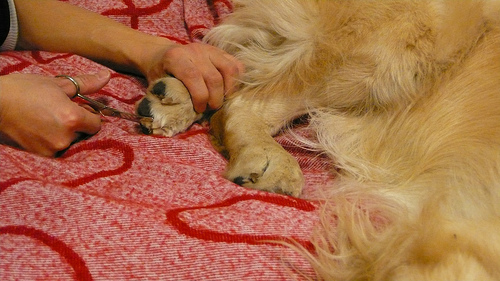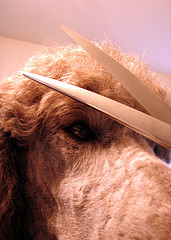Pet Society Hydra Eye and Ear Cleaner is ideal for cleansing and sanitizing the areas around the eyes and muzzle of both cats and dogs. This mild cleaner also helps to remove secretions, scabs, and unpleasant odors from around the eyes and on the face. Gently removes secretions and scabs from the eye area, snout and skin folds and neutralizes odors. Suitable for dogs and cats of all breeds.
Trimming Around Your Dog’s Paws

For more detail on the actual trimming process, please refer to our page on How To Trim Your Dog’s Paws.
Keeping the fur on your dog’s feet and paws trim is very important. Not only does it keep the dog looking neat and tidy, but it can also minimize the dog picking up such things as grass seeds and burrs or any other bits from the environment which may get caught up in the fur between their paws. Another reason for keeping your dog’s paw fur trim is that it will minimize the dirt that the dog brings inside the house. The fur in the “V” section between the back pad and the toe pads can sometimes get matted if left long, and also, particularly if bits of twig, grass seed or anything else gets caught there which could subsequently cause irritation and sores. The dog will be a lot more comfortable if you keep the paw hair trim.
 Trimming the dog’s paws can be tricky sometimes. The area between the dog’s paw pads can be very sensitive and ticklish so using dog grooming scissors or dog grooming clippers to trim the hair may cause the dog to squirm and wriggle. If this is the case, you may find it easier to trim your dog’s paws a little at a time. This means the dog doesn’t get too upset for a long period of time. If you are clipping the dog off all over, then you might find it easier alternating the clipping of the main body with trimming one paw at a time. If your dog is used to having his paws trimmed, then you might prefer to clip the body off first and then scissor between the paws; or, alternatively, you might find it easier to get two paws done after you have just gotten half way with the clippers. It is a matter of working around what tolerance level your dog has for grooming different parts of the body. If you haven’t trimmed the paws before and you’re not sure how the dog will go, try doing one paw (or even just part of one paw) and then having a break and going back to the next bit and so on until all four paws have been done.
Trimming the dog’s paws can be tricky sometimes. The area between the dog’s paw pads can be very sensitive and ticklish so using dog grooming scissors or dog grooming clippers to trim the hair may cause the dog to squirm and wriggle. If this is the case, you may find it easier to trim your dog’s paws a little at a time. This means the dog doesn’t get too upset for a long period of time. If you are clipping the dog off all over, then you might find it easier alternating the clipping of the main body with trimming one paw at a time. If your dog is used to having his paws trimmed, then you might prefer to clip the body off first and then scissor between the paws; or, alternatively, you might find it easier to get two paws done after you have just gotten half way with the clippers. It is a matter of working around what tolerance level your dog has for grooming different parts of the body. If you haven’t trimmed the paws before and you’re not sure how the dog will go, try doing one paw (or even just part of one paw) and then having a break and going back to the next bit and so on until all four paws have been done.
 4 Paws Recovery Cream for Dog Paws by Pet Wellbeing
4 Paws Recovery Cream for Dog Paws by Pet Wellbeing
Dogs’ paws are usually very resistant and tough, but sometimes external factors like cold or heat can cause the surfaces of the pads to become dry and, eventually, cracked. 4 Paws is designed to:
Penetrate easily into the rough paw skin
Repair skin damage
Strengthen the skin and protect it from further injury
A part of trimming your dog’s paws entails making sure that the nails stay trimmed also. Because there is a fair amount of information about trimming the paws, there is a separate page with instructions on how to clip the dog’s nails and how to trim your dog’s paws.
The equipment you will need for trimming the dog’s paws are a pair of sharp straight-edged scissors and possibly a pair of dog nail clippers, if the nails need trimming.
Cutting Your Dog’s Tail
For dogs who have long hair on their tails, you can either clip the fur off so it is the same length of coat as the body or you can simply brush it and trim the ends with dog grooming scissors to the length that you would like it to be. If you do choose to use the dog clippers over the tail, it is important to be careful that you don’t cut into the skin, particularly around the tip of the tail area. Run the clippers gently along the surface of the tail from the base at the body to the tip. You might want to use a shorter blade (refer to our page on Dog Clipper Blades) for the underneath where the tail joins the body near the anal area to avoid any feces sticking to the coat.
If you decide to brush the tail out and trim with scissors, then it will be important to get any knots out first. A slicker brush or rake (refer to our page on Dog Grooming Brushes and Dog Grooming Rakes and Shedding Tools) is the best type of brush to use for this, or it may be necessary to use a de-matting comb, to get the knots out (refer to our page on Dog Grooming Combs) if there are any. You can tell if the dog has any knotted areas by running a normal comb through the fur. If the comb gets stuck and you can’t pull it through then you know there is a knot to get out. The best tool for this is the de-matting comb. Use this comb by starting at the outside of the knotted area and plucking gradually until the matted part has been loosened and pulled away. Hold the tail and coat tight between your fingers close to the skin surface in order to minimize pulling on the dog’s skin as you brush out the knotted section. This de-matting can cause discomfort to the dog as you are slicing the knot out and some dogs are not very tolerant. If the area is too matted then it might be best to just use the clippers and shave the fur in these areas (refer to our page How to Groom a Matted Dog) or cut them out with the scissors. Either way, take care not to cut the dog.
You may find that there are no real knots but the comb does get a caught a little. It may be that you just need to brush it out a little with the slicker brush until the comb runs smoothly through the coat.
Trimming the Face


Once again, particular care needs to be taken when trimming the face, especially around the eyes, ears and mouth area. If you hold the ear up and back you can use the clippers to shave between the ear and the eye on each side.
It is personal preference as to whether you use clippers or scissors to trim the fur over the muzzle area. Use the clippers in the same direction that the fur falls, unless you are doing a poodle face which has the fur shaved back to the skin all over the face.
If you are scissoring the face you can use straight-edged scissors however this will show all the lines and probably not look very even. Thinning scissors work better because they don’t leave straight line scissoring cuts, they leave a more natural look and you can’t really tell that they dog’s face has been scissored.
 Geib Gator Ball Curved Shears 7.5 inch
Geib Gator Ball Curved Shears 7.5 inch
Geib Gator Ball Tip Curved Shears are crafted in traditional bullnose scissor fashion, and is perfect for both professional and amateur groomers. These durable and stylish scissors are perfect for fine detail trimming, such as on the face, ears, and paws.
If you decide to scissor your dog’s face firstly brush the fur around the muzzle so it gets rid of any bits of food or anything that might have stuck around the mouth area. Be careful when using the thinning scissors to trim the fur which hangs below the muzzle flap of skin up to just below the skin so as not to cut the dog. You can also use the thinning scissors to trim away the fur in the inner corner of the eye, however you need to be very careful here also to keep the dog still and not cut the skin. You can use these scissors also to trim the fur right back to the skin across the bridge of the nose. You might want to thin out the remaining fur on the muzzle. If you brush the hair from just above the eyes forward over the eye area and then you can use the normal scissors to trim it back so you get a nice straight cut just above the eyes. It is best to work on one side first and then the other. You may not find doing around your dog’s face quite so easy for the first couple of times but with a little practice it should become easier.
Related Pages:




